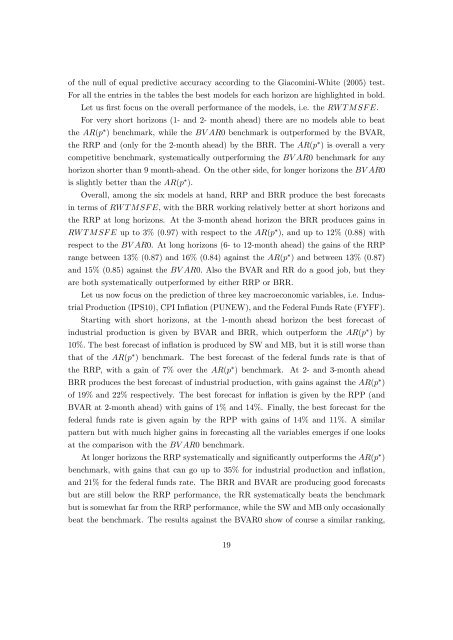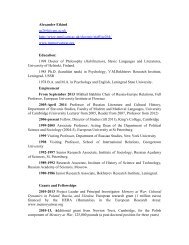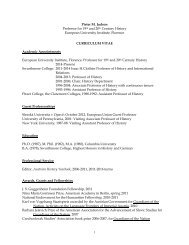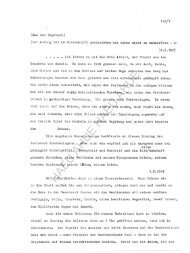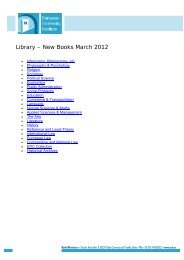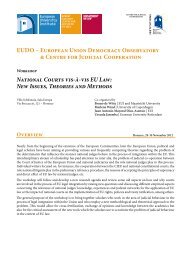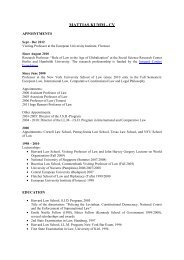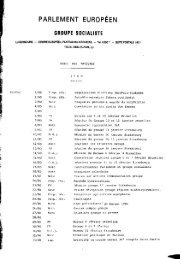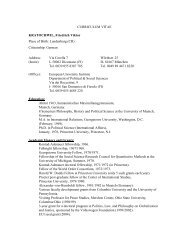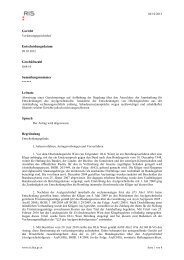Forecasting Large Datasets with Reduced Rank Multivariate Models
Forecasting Large Datasets with Reduced Rank Multivariate Models
Forecasting Large Datasets with Reduced Rank Multivariate Models
You also want an ePaper? Increase the reach of your titles
YUMPU automatically turns print PDFs into web optimized ePapers that Google loves.
of the null of equal predictive accuracy according to the Giacomini-White (2005) test.<br />
For all the entries in the tables the best models for each horizon are highlighted in bold.<br />
Let us …rst focus on the overall performance of the models, i.e. the RW T MSF E.<br />
For very short horizons (1- and 2- month ahead) there are no models able to beat<br />
the AR(p ) benchmark, while the BV AR0 benchmark is outperformed by the BVAR,<br />
the RRP and (only for the 2-month ahead) by the BRR. The AR(p ) is overall a very<br />
competitive benchmark, systematically outperforming the BV AR0 benchmark for any<br />
horizon shorter than 9 month-ahead. On the other side, for longer horizons the BV AR0<br />
is slightly better than the AR(p ).<br />
Overall, among the six models at hand, RRP and BRR produce the best forecasts<br />
in terms of RW T MSF E, <strong>with</strong> the BRR working relatively better at short horizons and<br />
the RRP at long horizons. At the 3-month ahead horizon the BRR produces gains in<br />
RW T MSF E up to 3% (0:97) <strong>with</strong> respect to the AR(p ), and up to 12% (0:88) <strong>with</strong><br />
respect to the BV AR0. At long horizons (6- to 12-month ahead) the gains of the RRP<br />
range between 13% (0:87) and 16% (0:84) against the AR(p ) and between 13% (0:87)<br />
and 15% (0:85) against the BV AR0. Also the BVAR and RR do a good job, but they<br />
are both systematically outperformed by either RRP or BRR.<br />
Let us now focus on the prediction of three key macroeconomic variables, i.e. Indus-<br />
trial Production (IPS10), CPI In‡ation (PUNEW), and the Federal Funds Rate (FYFF).<br />
Starting <strong>with</strong> short horizons, at the 1-month ahead horizon the best forecast of<br />
industrial production is given by BVAR and BRR, which outperform the AR(p ) by<br />
10%. The best forecast of in‡ation is produced by SW and MB, but it is still worse than<br />
that of the AR(p ) benchmark. The best forecast of the federal funds rate is that of<br />
the RRP, <strong>with</strong> a gain of 7% over the AR(p ) benchmark. At 2- and 3-month ahead<br />
BRR produces the best forecast of industrial production, <strong>with</strong> gains against the AR(p )<br />
of 19% and 22% respectively. The best forecast for in‡ation is given by the RPP (and<br />
BVAR at 2-month ahead) <strong>with</strong> gains of 1% and 14%. Finally, the best forecast for the<br />
federal funds rate is given again by the RPP <strong>with</strong> gains of 14% and 11%. A similar<br />
pattern but <strong>with</strong> much higher gains in forecasting all the variables emerges if one looks<br />
at the comparison <strong>with</strong> the BV AR0 benchmark.<br />
At longer horizons the RRP systematically and signi…cantly outperforms the AR(p )<br />
benchmark, <strong>with</strong> gains that can go up to 35% for industrial production and in‡ation,<br />
and 21% for the federal funds rate. The BRR and BVAR are producing good forecasts<br />
but are still below the RRP performance, the RR systematically beats the benchmark<br />
but is somewhat far from the RRP performance, while the SW and MB only occasionally<br />
beat the benchmark. The results against the BVAR0 show of course a similar ranking,<br />
19


